AF302 Report: Blockchain Technology, Food Slavery, and Lumachain
VerifiedAdded on 2022/10/14
|7
|2179
|17
Report
AI Summary
This report delves into Blockchain Technology, examining its core functionality as a decentralized, cryptographically secured system for storing and tracing information, as exemplified by Bitcoin. It explores the advantages, such as enhanced transaction security and transparency, alongside disadvantages like high energy consumption and transaction costs. The report analyzes the application of Blockchain in addressing food slavery, highlighting the work of Lumachain, which utilizes the technology to trace food products and ensure ethical sourcing. Furthermore, the report includes a case study of Bext360, which utilizes blockchain to improve social sustainability in the coffee supply chain. The report concludes by emphasizing the potential of Blockchain to transform industries, while also acknowledging the need for ongoing improvements to overcome existing limitations.
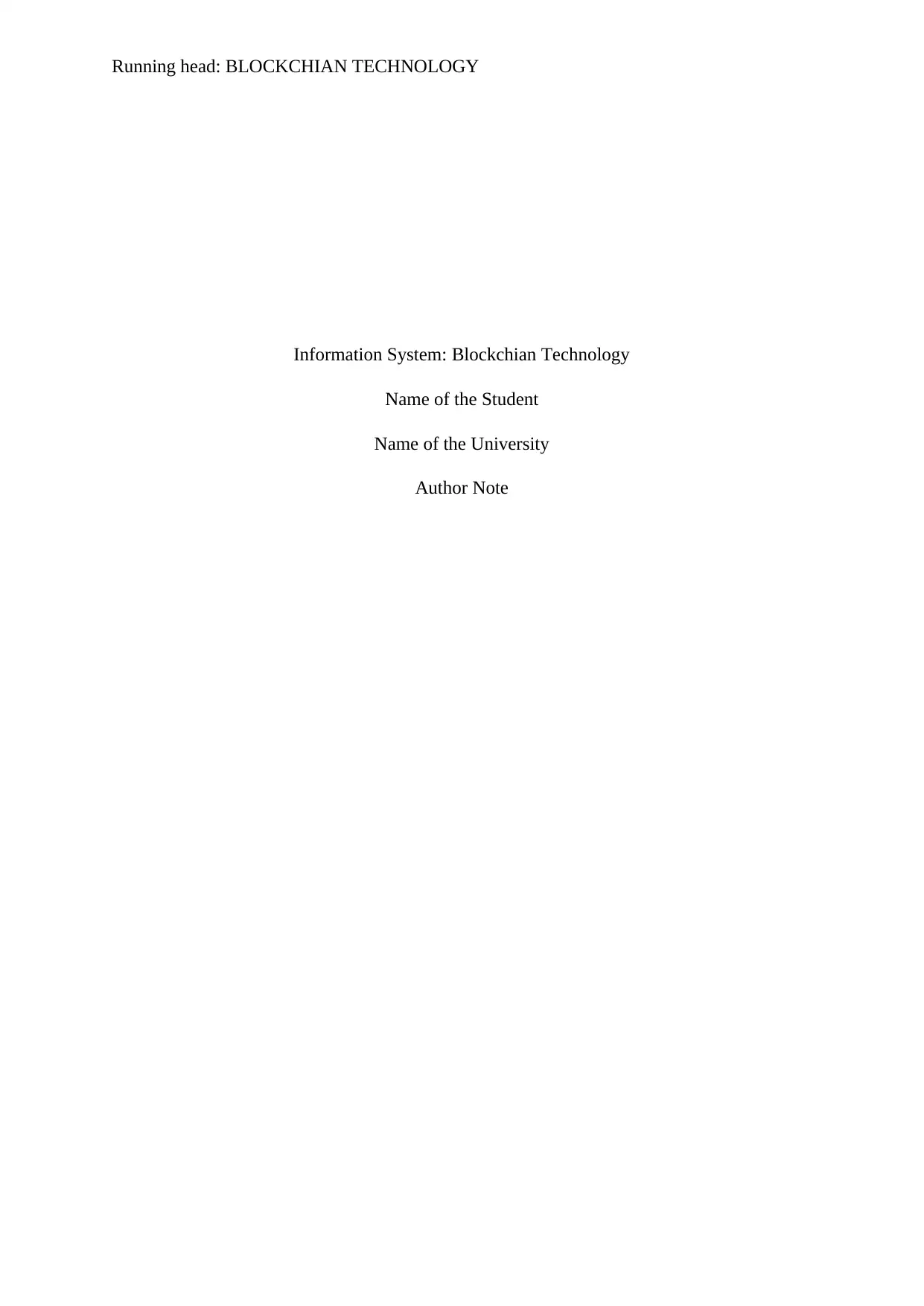
Running head: BLOCKCHIAN TECHNOLOGY
Information System: Blockchian Technology
Name of the Student
Name of the University
Author Note
Information System: Blockchian Technology
Name of the Student
Name of the University
Author Note
Paraphrase This Document
Need a fresh take? Get an instant paraphrase of this document with our AI Paraphraser
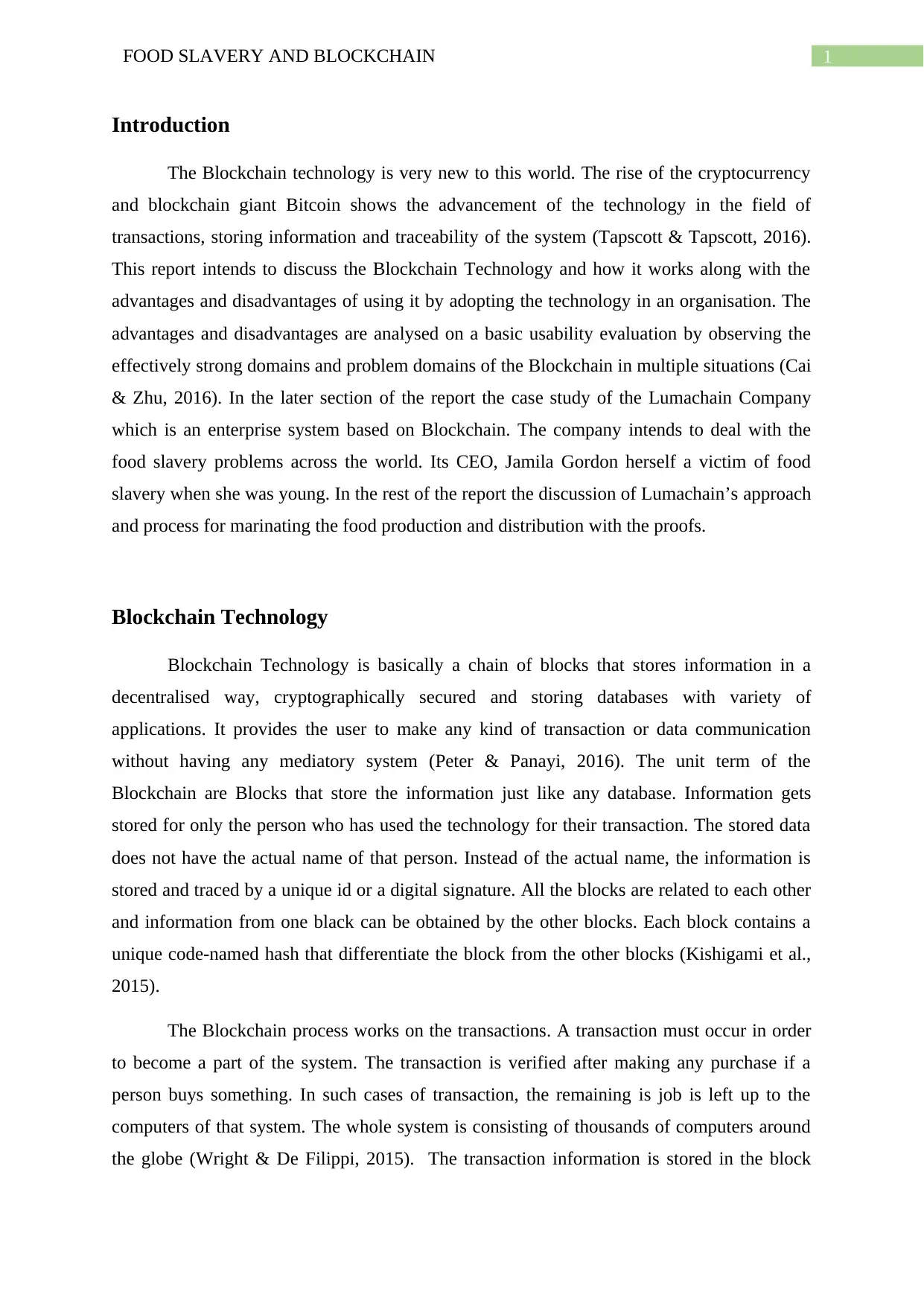
1FOOD SLAVERY AND BLOCKCHAIN
Introduction
The Blockchain technology is very new to this world. The rise of the cryptocurrency
and blockchain giant Bitcoin shows the advancement of the technology in the field of
transactions, storing information and traceability of the system (Tapscott & Tapscott, 2016).
This report intends to discuss the Blockchain Technology and how it works along with the
advantages and disadvantages of using it by adopting the technology in an organisation. The
advantages and disadvantages are analysed on a basic usability evaluation by observing the
effectively strong domains and problem domains of the Blockchain in multiple situations (Cai
& Zhu, 2016). In the later section of the report the case study of the Lumachain Company
which is an enterprise system based on Blockchain. The company intends to deal with the
food slavery problems across the world. Its CEO, Jamila Gordon herself a victim of food
slavery when she was young. In the rest of the report the discussion of Lumachain’s approach
and process for marinating the food production and distribution with the proofs.
Blockchain Technology
Blockchain Technology is basically a chain of blocks that stores information in a
decentralised way, cryptographically secured and storing databases with variety of
applications. It provides the user to make any kind of transaction or data communication
without having any mediatory system (Peter & Panayi, 2016). The unit term of the
Blockchain are Blocks that store the information just like any database. Information gets
stored for only the person who has used the technology for their transaction. The stored data
does not have the actual name of that person. Instead of the actual name, the information is
stored and traced by a unique id or a digital signature. All the blocks are related to each other
and information from one black can be obtained by the other blocks. Each block contains a
unique code-named hash that differentiate the block from the other blocks (Kishigami et al.,
2015).
The Blockchain process works on the transactions. A transaction must occur in order
to become a part of the system. The transaction is verified after making any purchase if a
person buys something. In such cases of transaction, the remaining is job is left up to the
computers of that system. The whole system is consisting of thousands of computers around
the globe (Wright & De Filippi, 2015). The transaction information is stored in the block
Introduction
The Blockchain technology is very new to this world. The rise of the cryptocurrency
and blockchain giant Bitcoin shows the advancement of the technology in the field of
transactions, storing information and traceability of the system (Tapscott & Tapscott, 2016).
This report intends to discuss the Blockchain Technology and how it works along with the
advantages and disadvantages of using it by adopting the technology in an organisation. The
advantages and disadvantages are analysed on a basic usability evaluation by observing the
effectively strong domains and problem domains of the Blockchain in multiple situations (Cai
& Zhu, 2016). In the later section of the report the case study of the Lumachain Company
which is an enterprise system based on Blockchain. The company intends to deal with the
food slavery problems across the world. Its CEO, Jamila Gordon herself a victim of food
slavery when she was young. In the rest of the report the discussion of Lumachain’s approach
and process for marinating the food production and distribution with the proofs.
Blockchain Technology
Blockchain Technology is basically a chain of blocks that stores information in a
decentralised way, cryptographically secured and storing databases with variety of
applications. It provides the user to make any kind of transaction or data communication
without having any mediatory system (Peter & Panayi, 2016). The unit term of the
Blockchain are Blocks that store the information just like any database. Information gets
stored for only the person who has used the technology for their transaction. The stored data
does not have the actual name of that person. Instead of the actual name, the information is
stored and traced by a unique id or a digital signature. All the blocks are related to each other
and information from one black can be obtained by the other blocks. Each block contains a
unique code-named hash that differentiate the block from the other blocks (Kishigami et al.,
2015).
The Blockchain process works on the transactions. A transaction must occur in order
to become a part of the system. The transaction is verified after making any purchase if a
person buys something. In such cases of transaction, the remaining is job is left up to the
computers of that system. The whole system is consisting of thousands of computers around
the globe (Wright & De Filippi, 2015). The transaction information is stored in the block
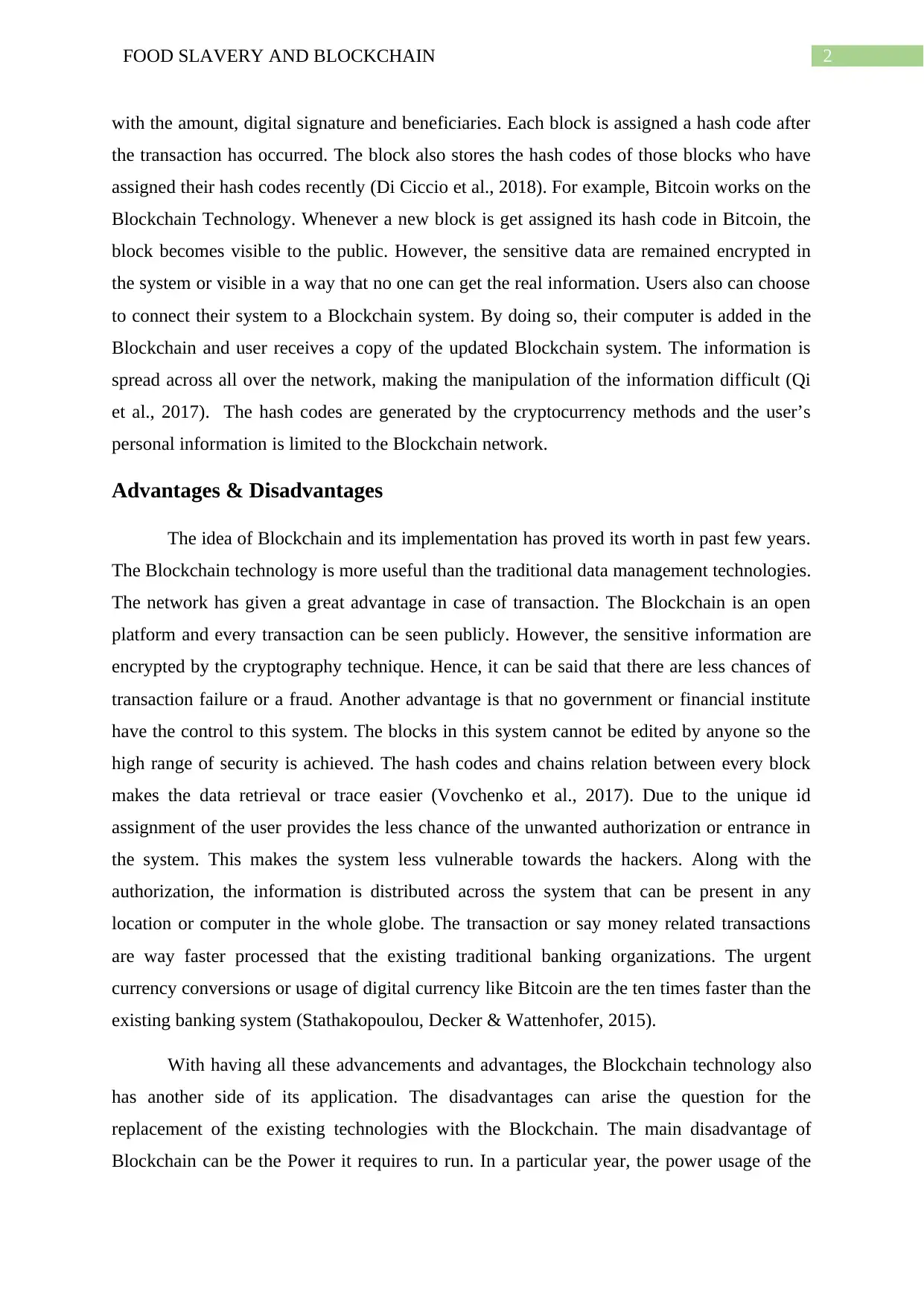
2FOOD SLAVERY AND BLOCKCHAIN
with the amount, digital signature and beneficiaries. Each block is assigned a hash code after
the transaction has occurred. The block also stores the hash codes of those blocks who have
assigned their hash codes recently (Di Ciccio et al., 2018). For example, Bitcoin works on the
Blockchain Technology. Whenever a new block is get assigned its hash code in Bitcoin, the
block becomes visible to the public. However, the sensitive data are remained encrypted in
the system or visible in a way that no one can get the real information. Users also can choose
to connect their system to a Blockchain system. By doing so, their computer is added in the
Blockchain and user receives a copy of the updated Blockchain system. The information is
spread across all over the network, making the manipulation of the information difficult (Qi
et al., 2017). The hash codes are generated by the cryptocurrency methods and the user’s
personal information is limited to the Blockchain network.
Advantages & Disadvantages
The idea of Blockchain and its implementation has proved its worth in past few years.
The Blockchain technology is more useful than the traditional data management technologies.
The network has given a great advantage in case of transaction. The Blockchain is an open
platform and every transaction can be seen publicly. However, the sensitive information are
encrypted by the cryptography technique. Hence, it can be said that there are less chances of
transaction failure or a fraud. Another advantage is that no government or financial institute
have the control to this system. The blocks in this system cannot be edited by anyone so the
high range of security is achieved. The hash codes and chains relation between every block
makes the data retrieval or trace easier (Vovchenko et al., 2017). Due to the unique id
assignment of the user provides the less chance of the unwanted authorization or entrance in
the system. This makes the system less vulnerable towards the hackers. Along with the
authorization, the information is distributed across the system that can be present in any
location or computer in the whole globe. The transaction or say money related transactions
are way faster processed that the existing traditional banking organizations. The urgent
currency conversions or usage of digital currency like Bitcoin are the ten times faster than the
existing banking system (Stathakopoulou, Decker & Wattenhofer, 2015).
With having all these advancements and advantages, the Blockchain technology also
has another side of its application. The disadvantages can arise the question for the
replacement of the existing technologies with the Blockchain. The main disadvantage of
Blockchain can be the Power it requires to run. In a particular year, the power usage of the
with the amount, digital signature and beneficiaries. Each block is assigned a hash code after
the transaction has occurred. The block also stores the hash codes of those blocks who have
assigned their hash codes recently (Di Ciccio et al., 2018). For example, Bitcoin works on the
Blockchain Technology. Whenever a new block is get assigned its hash code in Bitcoin, the
block becomes visible to the public. However, the sensitive data are remained encrypted in
the system or visible in a way that no one can get the real information. Users also can choose
to connect their system to a Blockchain system. By doing so, their computer is added in the
Blockchain and user receives a copy of the updated Blockchain system. The information is
spread across all over the network, making the manipulation of the information difficult (Qi
et al., 2017). The hash codes are generated by the cryptocurrency methods and the user’s
personal information is limited to the Blockchain network.
Advantages & Disadvantages
The idea of Blockchain and its implementation has proved its worth in past few years.
The Blockchain technology is more useful than the traditional data management technologies.
The network has given a great advantage in case of transaction. The Blockchain is an open
platform and every transaction can be seen publicly. However, the sensitive information are
encrypted by the cryptography technique. Hence, it can be said that there are less chances of
transaction failure or a fraud. Another advantage is that no government or financial institute
have the control to this system. The blocks in this system cannot be edited by anyone so the
high range of security is achieved. The hash codes and chains relation between every block
makes the data retrieval or trace easier (Vovchenko et al., 2017). Due to the unique id
assignment of the user provides the less chance of the unwanted authorization or entrance in
the system. This makes the system less vulnerable towards the hackers. Along with the
authorization, the information is distributed across the system that can be present in any
location or computer in the whole globe. The transaction or say money related transactions
are way faster processed that the existing traditional banking organizations. The urgent
currency conversions or usage of digital currency like Bitcoin are the ten times faster than the
existing banking system (Stathakopoulou, Decker & Wattenhofer, 2015).
With having all these advancements and advantages, the Blockchain technology also
has another side of its application. The disadvantages can arise the question for the
replacement of the existing technologies with the Blockchain. The main disadvantage of
Blockchain can be the Power it requires to run. In a particular year, the power usage of the
⊘ This is a preview!⊘
Do you want full access?
Subscribe today to unlock all pages.

Trusted by 1+ million students worldwide
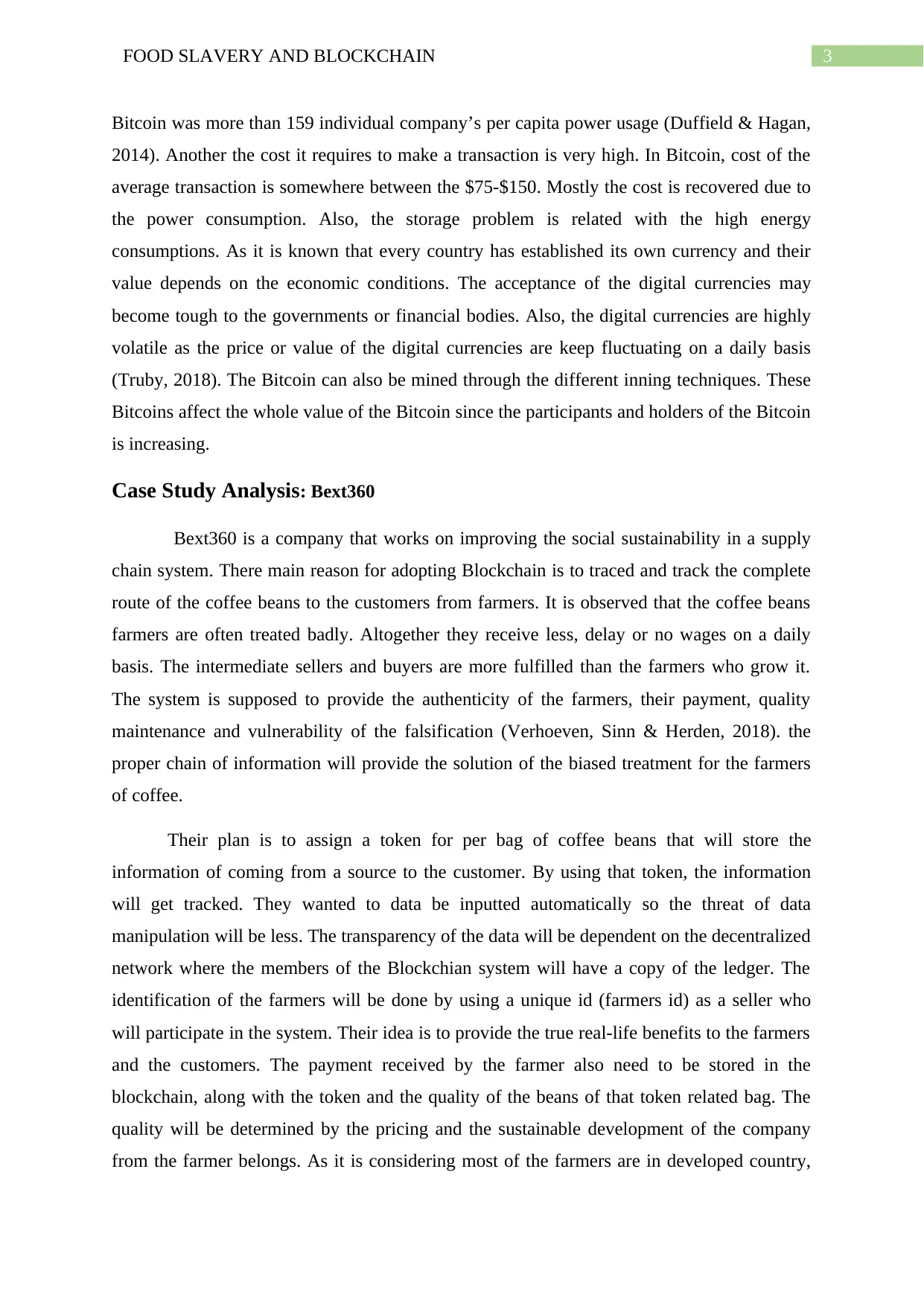
3FOOD SLAVERY AND BLOCKCHAIN
Bitcoin was more than 159 individual company’s per capita power usage (Duffield & Hagan,
2014). Another the cost it requires to make a transaction is very high. In Bitcoin, cost of the
average transaction is somewhere between the $75-$150. Mostly the cost is recovered due to
the power consumption. Also, the storage problem is related with the high energy
consumptions. As it is known that every country has established its own currency and their
value depends on the economic conditions. The acceptance of the digital currencies may
become tough to the governments or financial bodies. Also, the digital currencies are highly
volatile as the price or value of the digital currencies are keep fluctuating on a daily basis
(Truby, 2018). The Bitcoin can also be mined through the different inning techniques. These
Bitcoins affect the whole value of the Bitcoin since the participants and holders of the Bitcoin
is increasing.
Case Study Analysis: Bext360
Bext360 is a company that works on improving the social sustainability in a supply
chain system. There main reason for adopting Blockchain is to traced and track the complete
route of the coffee beans to the customers from farmers. It is observed that the coffee beans
farmers are often treated badly. Altogether they receive less, delay or no wages on a daily
basis. The intermediate sellers and buyers are more fulfilled than the farmers who grow it.
The system is supposed to provide the authenticity of the farmers, their payment, quality
maintenance and vulnerability of the falsification (Verhoeven, Sinn & Herden, 2018). the
proper chain of information will provide the solution of the biased treatment for the farmers
of coffee.
Their plan is to assign a token for per bag of coffee beans that will store the
information of coming from a source to the customer. By using that token, the information
will get tracked. They wanted to data be inputted automatically so the threat of data
manipulation will be less. The transparency of the data will be dependent on the decentralized
network where the members of the Blockchian system will have a copy of the ledger. The
identification of the farmers will be done by using a unique id (farmers id) as a seller who
will participate in the system. Their idea is to provide the true real-life benefits to the farmers
and the customers. The payment received by the farmer also need to be stored in the
blockchain, along with the token and the quality of the beans of that token related bag. The
quality will be determined by the pricing and the sustainable development of the company
from the farmer belongs. As it is considering most of the farmers are in developed country,
Bitcoin was more than 159 individual company’s per capita power usage (Duffield & Hagan,
2014). Another the cost it requires to make a transaction is very high. In Bitcoin, cost of the
average transaction is somewhere between the $75-$150. Mostly the cost is recovered due to
the power consumption. Also, the storage problem is related with the high energy
consumptions. As it is known that every country has established its own currency and their
value depends on the economic conditions. The acceptance of the digital currencies may
become tough to the governments or financial bodies. Also, the digital currencies are highly
volatile as the price or value of the digital currencies are keep fluctuating on a daily basis
(Truby, 2018). The Bitcoin can also be mined through the different inning techniques. These
Bitcoins affect the whole value of the Bitcoin since the participants and holders of the Bitcoin
is increasing.
Case Study Analysis: Bext360
Bext360 is a company that works on improving the social sustainability in a supply
chain system. There main reason for adopting Blockchain is to traced and track the complete
route of the coffee beans to the customers from farmers. It is observed that the coffee beans
farmers are often treated badly. Altogether they receive less, delay or no wages on a daily
basis. The intermediate sellers and buyers are more fulfilled than the farmers who grow it.
The system is supposed to provide the authenticity of the farmers, their payment, quality
maintenance and vulnerability of the falsification (Verhoeven, Sinn & Herden, 2018). the
proper chain of information will provide the solution of the biased treatment for the farmers
of coffee.
Their plan is to assign a token for per bag of coffee beans that will store the
information of coming from a source to the customer. By using that token, the information
will get tracked. They wanted to data be inputted automatically so the threat of data
manipulation will be less. The transparency of the data will be dependent on the decentralized
network where the members of the Blockchian system will have a copy of the ledger. The
identification of the farmers will be done by using a unique id (farmers id) as a seller who
will participate in the system. Their idea is to provide the true real-life benefits to the farmers
and the customers. The payment received by the farmer also need to be stored in the
blockchain, along with the token and the quality of the beans of that token related bag. The
quality will be determined by the pricing and the sustainable development of the company
from the farmer belongs. As it is considering most of the farmers are in developed country,
Paraphrase This Document
Need a fresh take? Get an instant paraphrase of this document with our AI Paraphraser
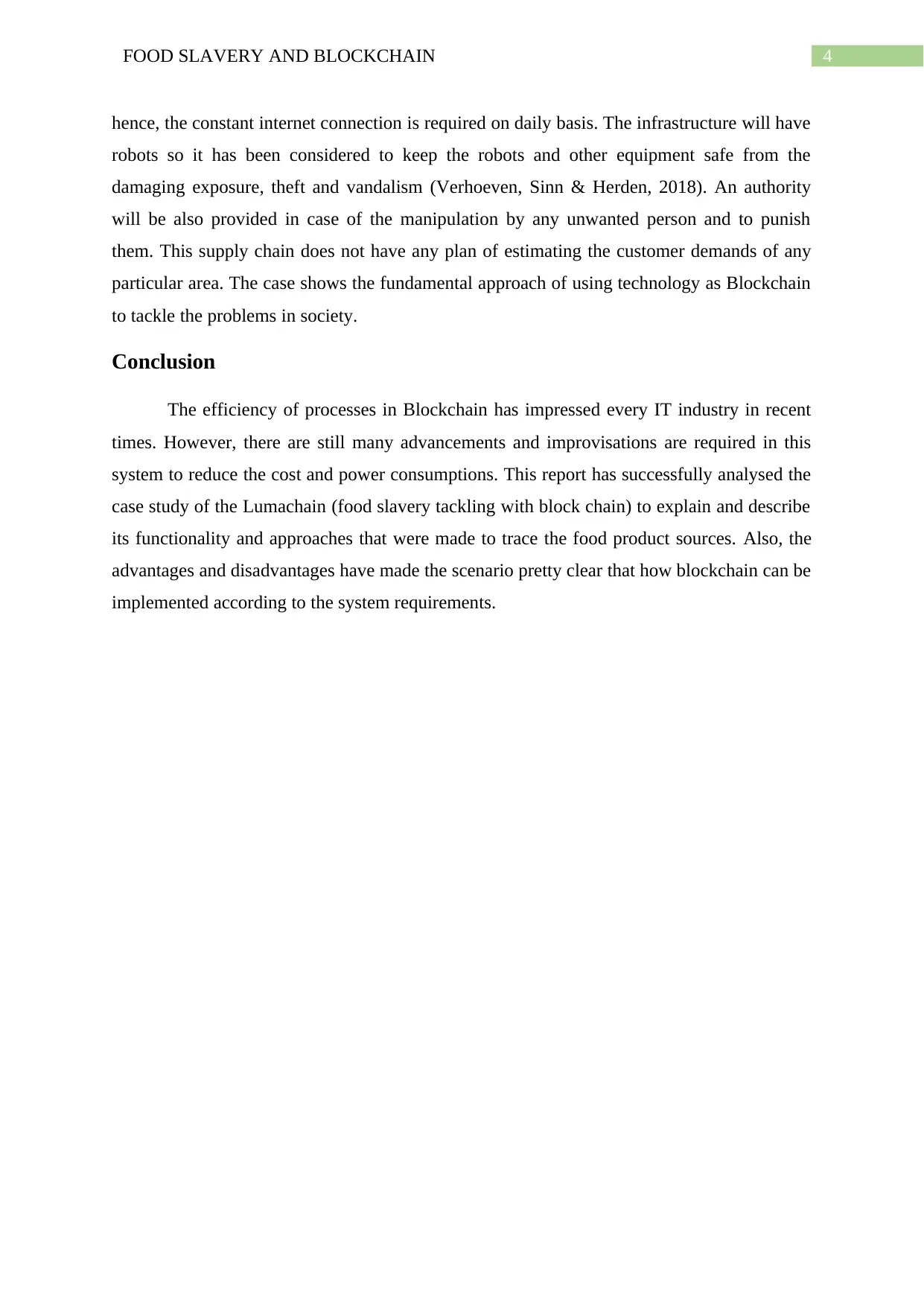
4FOOD SLAVERY AND BLOCKCHAIN
hence, the constant internet connection is required on daily basis. The infrastructure will have
robots so it has been considered to keep the robots and other equipment safe from the
damaging exposure, theft and vandalism (Verhoeven, Sinn & Herden, 2018). An authority
will be also provided in case of the manipulation by any unwanted person and to punish
them. This supply chain does not have any plan of estimating the customer demands of any
particular area. The case shows the fundamental approach of using technology as Blockchain
to tackle the problems in society.
Conclusion
The efficiency of processes in Blockchain has impressed every IT industry in recent
times. However, there are still many advancements and improvisations are required in this
system to reduce the cost and power consumptions. This report has successfully analysed the
case study of the Lumachain (food slavery tackling with block chain) to explain and describe
its functionality and approaches that were made to trace the food product sources. Also, the
advantages and disadvantages have made the scenario pretty clear that how blockchain can be
implemented according to the system requirements.
hence, the constant internet connection is required on daily basis. The infrastructure will have
robots so it has been considered to keep the robots and other equipment safe from the
damaging exposure, theft and vandalism (Verhoeven, Sinn & Herden, 2018). An authority
will be also provided in case of the manipulation by any unwanted person and to punish
them. This supply chain does not have any plan of estimating the customer demands of any
particular area. The case shows the fundamental approach of using technology as Blockchain
to tackle the problems in society.
Conclusion
The efficiency of processes in Blockchain has impressed every IT industry in recent
times. However, there are still many advancements and improvisations are required in this
system to reduce the cost and power consumptions. This report has successfully analysed the
case study of the Lumachain (food slavery tackling with block chain) to explain and describe
its functionality and approaches that were made to trace the food product sources. Also, the
advantages and disadvantages have made the scenario pretty clear that how blockchain can be
implemented according to the system requirements.
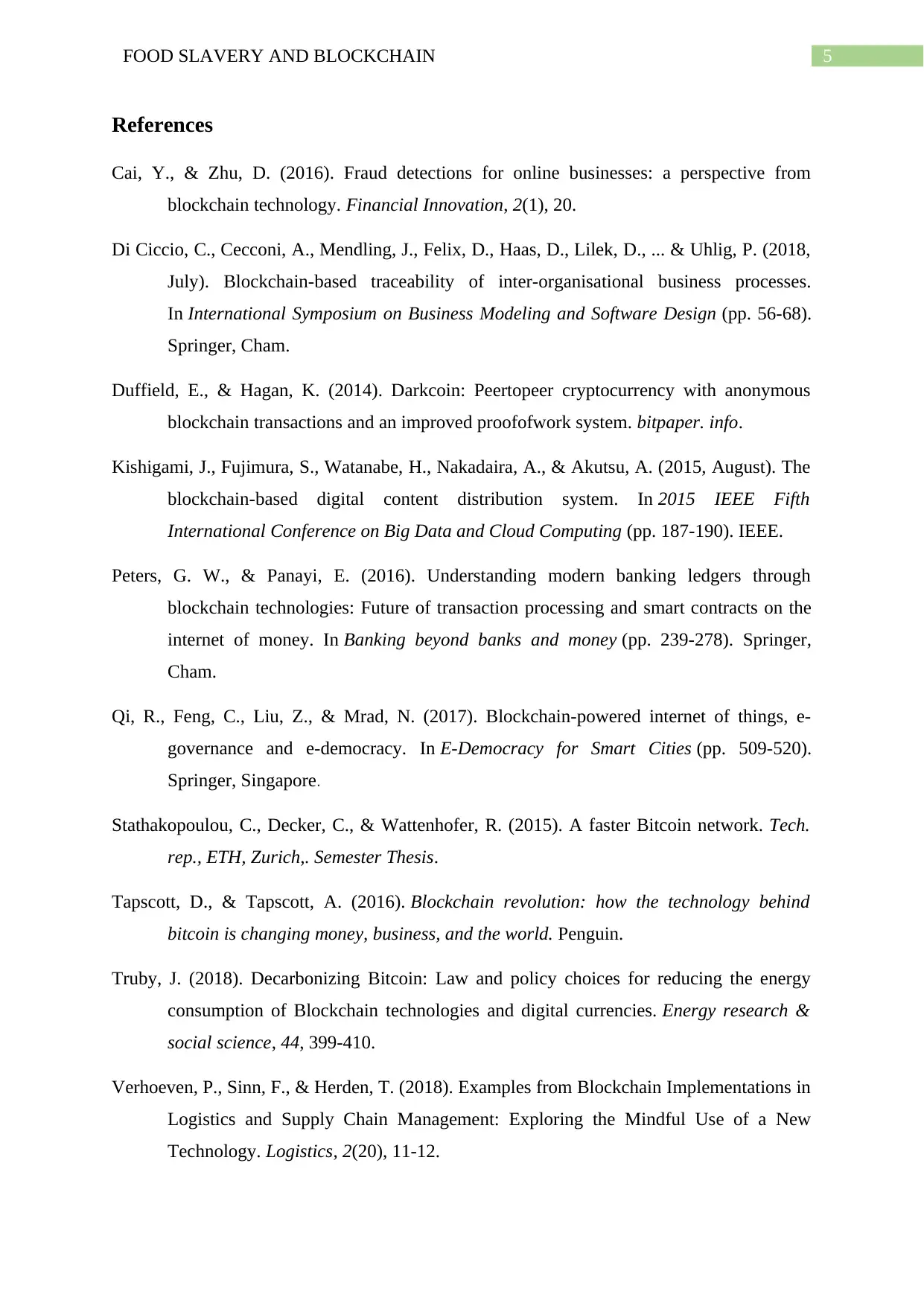
5FOOD SLAVERY AND BLOCKCHAIN
References
Cai, Y., & Zhu, D. (2016). Fraud detections for online businesses: a perspective from
blockchain technology. Financial Innovation, 2(1), 20.
Di Ciccio, C., Cecconi, A., Mendling, J., Felix, D., Haas, D., Lilek, D., ... & Uhlig, P. (2018,
July). Blockchain-based traceability of inter-organisational business processes.
In International Symposium on Business Modeling and Software Design (pp. 56-68).
Springer, Cham.
Duffield, E., & Hagan, K. (2014). Darkcoin: Peertopeer cryptocurrency with anonymous
blockchain transactions and an improved proofofwork system. bitpaper. info.
Kishigami, J., Fujimura, S., Watanabe, H., Nakadaira, A., & Akutsu, A. (2015, August). The
blockchain-based digital content distribution system. In 2015 IEEE Fifth
International Conference on Big Data and Cloud Computing (pp. 187-190). IEEE.
Peters, G. W., & Panayi, E. (2016). Understanding modern banking ledgers through
blockchain technologies: Future of transaction processing and smart contracts on the
internet of money. In Banking beyond banks and money (pp. 239-278). Springer,
Cham.
Qi, R., Feng, C., Liu, Z., & Mrad, N. (2017). Blockchain-powered internet of things, e-
governance and e-democracy. In E-Democracy for Smart Cities (pp. 509-520).
Springer, Singapore.
Stathakopoulou, C., Decker, C., & Wattenhofer, R. (2015). A faster Bitcoin network. Tech.
rep., ETH, Zurich,. Semester Thesis.
Tapscott, D., & Tapscott, A. (2016). Blockchain revolution: how the technology behind
bitcoin is changing money, business, and the world. Penguin.
Truby, J. (2018). Decarbonizing Bitcoin: Law and policy choices for reducing the energy
consumption of Blockchain technologies and digital currencies. Energy research &
social science, 44, 399-410.
Verhoeven, P., Sinn, F., & Herden, T. (2018). Examples from Blockchain Implementations in
Logistics and Supply Chain Management: Exploring the Mindful Use of a New
Technology. Logistics, 2(20), 11-12.
References
Cai, Y., & Zhu, D. (2016). Fraud detections for online businesses: a perspective from
blockchain technology. Financial Innovation, 2(1), 20.
Di Ciccio, C., Cecconi, A., Mendling, J., Felix, D., Haas, D., Lilek, D., ... & Uhlig, P. (2018,
July). Blockchain-based traceability of inter-organisational business processes.
In International Symposium on Business Modeling and Software Design (pp. 56-68).
Springer, Cham.
Duffield, E., & Hagan, K. (2014). Darkcoin: Peertopeer cryptocurrency with anonymous
blockchain transactions and an improved proofofwork system. bitpaper. info.
Kishigami, J., Fujimura, S., Watanabe, H., Nakadaira, A., & Akutsu, A. (2015, August). The
blockchain-based digital content distribution system. In 2015 IEEE Fifth
International Conference on Big Data and Cloud Computing (pp. 187-190). IEEE.
Peters, G. W., & Panayi, E. (2016). Understanding modern banking ledgers through
blockchain technologies: Future of transaction processing and smart contracts on the
internet of money. In Banking beyond banks and money (pp. 239-278). Springer,
Cham.
Qi, R., Feng, C., Liu, Z., & Mrad, N. (2017). Blockchain-powered internet of things, e-
governance and e-democracy. In E-Democracy for Smart Cities (pp. 509-520).
Springer, Singapore.
Stathakopoulou, C., Decker, C., & Wattenhofer, R. (2015). A faster Bitcoin network. Tech.
rep., ETH, Zurich,. Semester Thesis.
Tapscott, D., & Tapscott, A. (2016). Blockchain revolution: how the technology behind
bitcoin is changing money, business, and the world. Penguin.
Truby, J. (2018). Decarbonizing Bitcoin: Law and policy choices for reducing the energy
consumption of Blockchain technologies and digital currencies. Energy research &
social science, 44, 399-410.
Verhoeven, P., Sinn, F., & Herden, T. (2018). Examples from Blockchain Implementations in
Logistics and Supply Chain Management: Exploring the Mindful Use of a New
Technology. Logistics, 2(20), 11-12.
⊘ This is a preview!⊘
Do you want full access?
Subscribe today to unlock all pages.

Trusted by 1+ million students worldwide
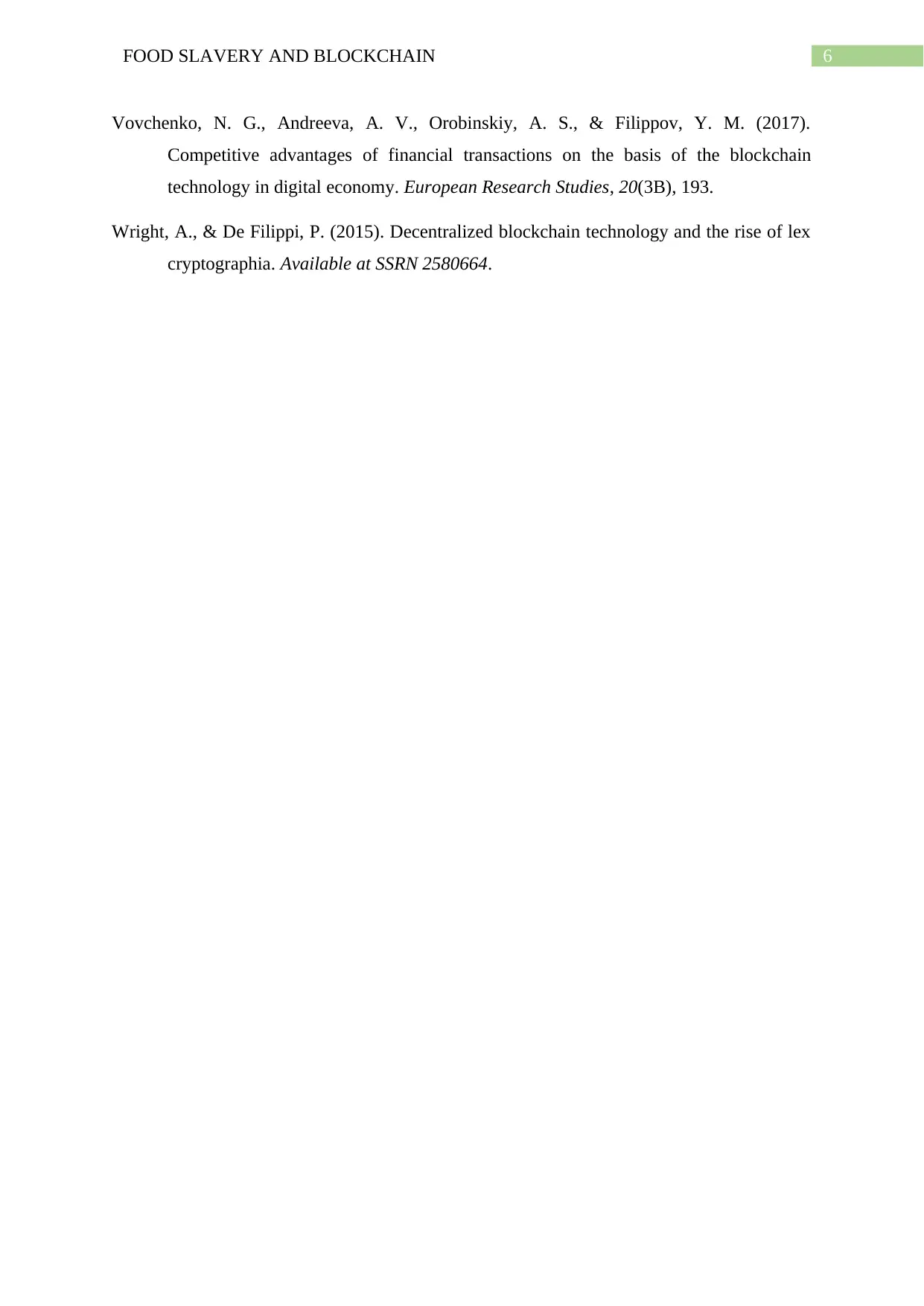
6FOOD SLAVERY AND BLOCKCHAIN
Vovchenko, N. G., Andreeva, A. V., Orobinskiy, A. S., & Filippov, Y. M. (2017).
Competitive advantages of financial transactions on the basis of the blockchain
technology in digital economy. European Research Studies, 20(3B), 193.
Wright, A., & De Filippi, P. (2015). Decentralized blockchain technology and the rise of lex
cryptographia. Available at SSRN 2580664.
Vovchenko, N. G., Andreeva, A. V., Orobinskiy, A. S., & Filippov, Y. M. (2017).
Competitive advantages of financial transactions on the basis of the blockchain
technology in digital economy. European Research Studies, 20(3B), 193.
Wright, A., & De Filippi, P. (2015). Decentralized blockchain technology and the rise of lex
cryptographia. Available at SSRN 2580664.
1 out of 7
Related Documents
Your All-in-One AI-Powered Toolkit for Academic Success.
+13062052269
info@desklib.com
Available 24*7 on WhatsApp / Email
![[object Object]](/_next/static/media/star-bottom.7253800d.svg)
Unlock your academic potential
Copyright © 2020–2025 A2Z Services. All Rights Reserved. Developed and managed by ZUCOL.




